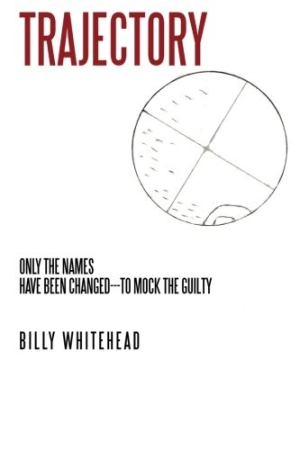Trajectory
A traumatized veteran feels duped by his nation in this ambitious novel with something relevant to say.
In Billy Whitehead’s Trajectory, Iraq War veteran Brad Soames returns home suffering the loss of friends killed in the line of duty. Enraged by the senselessness of their deaths and the war itself, Brad engages in a two-year shooting spree, targeting the policymakers and government officials who concocted the rationale for war. Equally infuriated by corporate greed and crony capitalism, Brad assassinates corrupt politicians and lobbyists and profiteering CEOs of multinational banking and investment corporations. The spate of murders prompts a national debate about the virtue and immorality of the sniper’s vigilante justice as well as the country’s troubling trajectory—the themes Whitehead explores in this ambitious and admonitory novel.
Brad’s victims comprise a real-life who’s who of Washington insiders and Wall Street executives, except that “the names have been changed to mock the guilty,” as the book’s cover declares. Some of the book’s notable names (though not necessarily victims) include Secretary of Defense Donnie Rummyfield; Coyote Network show host Glen Peckerwood; EXrun CEO Len Kay; and Senior Assistant to President Vibes Lentago, Kal Stove. While such nomenclature is clever and comical, its fancifulness does more to undermine the novel’s solemnity than deride the malefactors.
The book begins with Brad’s first kill. He murders Roberto Nowiki, a conservative political columnist who publicly identified CIA operative Bonita Flaime. The scene is convincing, descriptive, and suspenseful. Storytelling thereafter diminishes, and this first chapter establishes a pattern of spelling inconsistencies. “Nowiki” appears first, and then it switches to “Nowicki.” Elsewhere, there emerges “US” and “U.S.;” “Sniper” and “sniper;” “Leakeyship” and “Leakyship;” “Granger” and “Grainger;” “Mussie” and “Muskie.”
Structurally, the story is told in two hundred chapters that vary in length, viewpoint, and font, making for a confusing and arduous reading experience. For example, chapters printed in Courier font read like newspaper articles and most often announce the identity of Brad’s latest victim and the details of his attack. However, it isn’t implicit that they are newspaper articles, and it is difficult to determine from whose viewpoint they derive. Things get murkier when chapters printed in a customary font include bylines from Clark Kant, Peter Pea Parker, and The Curmudgeon. Additionally, quick scene changes with scant transitional phrasing, punctuation errors, and colloquial dialogue like “Nice to meetcha, sorta;” “J’ya like it?;” and “Howzit comin’” are off-putting.
Despite these missteps, Brad’s plight as a traumatized veteran who feels duped by the nation’s underhanded policies and the salvation he experiences when he falls in love with Sada lend an emotive element to the storyline. Several chapters that decry America’s foreign policy and posit society-versus-the-individual theorizing leave Trajectory with something relevant to say.
Reviewed by
Amy O'Loughlin
Disclosure: This article is not an endorsement, but a review. The publisher of this book provided free copies of the book and paid a small fee to have their book reviewed by a professional reviewer. Foreword Reviews and Clarion Reviews make no guarantee that the publisher will receive a positive review. Foreword Magazine, Inc. is disclosing this in accordance with the Federal Trade Commission’s 16 CFR, Part 255.

